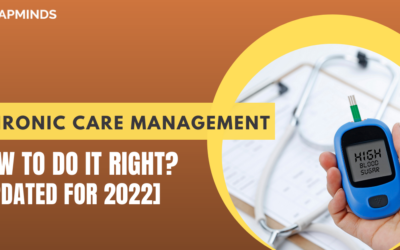Top 4 Remote Technologies For Chronic Care Management
As the healthcare industry quickly tips toward a largely remote business, providers are confronted with a key challenge: how can they engage their chronic disease management populations?
Individuals with a chronic illness have long required a high-touch patient engagement strategy, with providers bringing these patients in regularly for health check-ins, health coaching, and overall disease monitoring. This approach has sought to prevent patients from experiencing an acute care episode by addressing smaller problems at short intervals.
But as the industry continues to become more remote, both in an attempt to drive convenience for patients and cut down on clinic foot traffic, providers need to pivot that high-touch engagement strategy.
That does not mean switching high-touch in exchange for low-touch engagement. Instead, it means having high-touch go virtual. Providers will need to lean on a suite of patient engagement technologies for remote chronic disease management.
Digital Medication Management
At the core of a good chronic disease management plan is a good medication adherence plan. Medication adherence is a billion-dollar healthcare problem. According to a seminal 2012 study in the Annals of Internal Medicine, medication non-adherence caused nearly 125,000 deaths, prompted 10 percent of hospitalizations, and cost the medical industry between $100 and $289 million.
The driving factor here is simple: when a patient cannot or does not take her chronic care management medications as prescribed, her disease state will suffer. Providers recognize their role in helping patients stick to those care management plans.
To be clear, the medical industry is in agreement that a large hurdle for medication adherence is cost. Prescription drug costs are astronomical, and data shows that patients will skip a dose or not fill a prescription altogether because of a high price tag.
But another component to lacking medication adherence is patient behavior. While close to zero patients choose to be non-adherent because they want to be termed “difficult,” many do face challenges managing their medications, especially if they take multiple each day.
Organization is critical to helping patients keep track of multiple medications. Medication adherence apps have proven effective for some patients.
A 2016 study in the Journal of the American Medical Informatics Association (JAMIA) showed that medication adherence apps can boost adherence for many patients, save for those who are older and non-white. This may be because of limited technology adoption, lower health literacy, and helplessness in their disease states.
In the time that has passed since that study, digital health literacy is higher among most patients, making it more likely these tools could be effective.
For patients with multiple medications, it is also helpful to synchronize medications. This means multiple prescriptions will be filled for the same number of days, ensuring the patient will refill each of her prescriptions on the say day. This eliminates the issue of having multiple pharmacy visits for different drugs within a short time period.
Finally, virtual strategies that help providers detect non-adherence may be beneficial.
The pill box sends doctors a remote monitoring message each time the patient opens the pill box, providing doctors with the information necessary to detect adherence issues.
Of course, this tool is not useful for all patients. Some might perceive the pill box as a “Big Brother” surveillance effort and be resistant to the idea. It is important for providers to work with patients to determine how a medication management strategy will adhere to patient preferences.
Remote Patient Monitoring Devices
Remote patient monitoring devices are central to helping clinicians collect patient data and monitor disease state from afar. These technologies are plentiful, ranging from wearable devices to Bluetooth blood pressure cuffs to blood glucose monitors.
The remote patient monitoring device usually interoperates with the patient portal or EHR, allowing clinicians to view and analyze patient-generated health data and flag irregularities. From there, providers can escalate care intervention where necessary.
Remote patient monitoring devices have been a part of the digital health conversation for several years, but now as healthcare is increasingly going virtual they may find a more permanent place in patient care. However, two central challenges lay ahead.
Foremost, remote patient monitoring devices, especially the larger technologies like the Bluetooth blood pressure cuffs or blood glucose monitors, have a financial barrier.
These are not typical items found in most patient homes, and purchasing such tools could run patients out $50 or $100 for relatively basic models. And for a provider, especially a primary care provider, to issue these tools presents a logistical and financial challenge.
As healthcare professionals continue to recognize the importance of remote patient monitoring tools, it may be helpful for healthcare payers to create financial incentives for using them or incorporate remote monitoring devices into their covered benefits.
Use of remote patient monitoring tools, especially wearable technology, is also challenging because adoption among chronically ill patients is not yet ubiquitous. Research from Forrester showed that only 21 percent of those who use a wearable have a chronic illness. Barriers to adoption include perceived utility, lack of features that make life easier, and security concerns.
Payers and providers alike may benefit from reframing how they promote these technologies to potential users, particularly those with chronic illness. After all, around 50 percent said they’d be open to using a wearable.
Most patients with chronic illness said they’d use a tool that helps them track their sleep, their heart rate, blood pressure, and physical activity. Sixty-four and 63 percent of patients are interested in using a wearable that is subsidized by their provider and insurers, respectively. Sixty percent are comfortable sharing PGHD with their providers, while that figure is still a little low with insurers (48 percent).
Stakeholders may see more widespread buy-in from chronically ill populations if they offered subsidized access to wearable tools that deliver on patient preferences.
RELATED: ALL ABOUT REMOTE PATIENT MONITORING(RPM) DEVICES
Telehealth and Video Visits
Although important, reviewing and responding to patient data through remote monitoring devices is only half the battle; telehealth offers the opportunity for providers to hold an interpersonal interaction, albeit with a screen separating themselves and the patient.
In doing so, clinicians can deliver meaningful health coaching to their chronic care populations. This hinges on building a strong patient-provider relationship.
Clinicians and patients using telehealth may at first feel hampered by the physical presence of the computer screen that separates them; it may feel awkward to interact over video chat or another asynchronous modality.
But by utilizing certain digital communication strategies, clinicians can work to forge a strong bond between themselves and the patient that ideally stems into meaningful healthcare engagement.
Most experts recommend providers continue to dress the part when holding a telehealth visit. They should also conduct the virtual visit in a quiet, organized, and private space. Clinicians should avoid looking into the patient’s eyes during a visit and rather look into their webcams. Making eye contact with the video screen will give the appearance the provider’s eyes are cast downwards, experts say.
When communicating, it is important providers continue to lean on their same interpersonal skills they use in the physical clinical space. Being empathetic, friendly, and encouraging will remain essential even when delivering care via telehealth.
RELATED: THE ULTIMATE ROUND-UP OF TELEHEALTH VISITS IN 4 STEPS
Secure Direct Messaging Tools
Like telehealth, secure direct messaging is important for maintaining the patient-provider relationship. Unlike telehealth, however, secure direct messaging might be better to answer quick patient questions, provide a nudge for a new healthy behavior, or remind a patient about a health check-in.
Clinicians can use secure direct messaging for chronic disease management by giving health coaching tips for patients, doing a quick check-in with a patient, or asking a patient about any irregular data gleaned from a remote monitoring device or wearable.
Conversely, chronically ill patients may use secure messaging to ask their providers a question or seek health advice. Secure direct messaging is most commonly done via the patient portal, which has long played host to these kinds of chat functionalities.
Experts recommend providers using secure direct messaging outline with patients the best ways to use the technology, what types of requests are best for secure direct message, and a standard timeframe in which the provider will respond to messages.
Final Thoughts
Remote patient care is likely here to stay. It is convenient for the patient, and therefore can help drive higher patient satisfaction. As more payers and providers embrace this new reality, tapping key patient engagement technologies will be essential for conducting remote chronic care management.
Using the right CCM partner, such as CapMinds, can help healthcare practices to provide high-quality chronic care management services and optimize revenue without any additional burdens.




